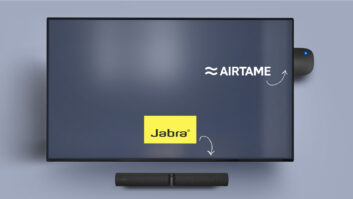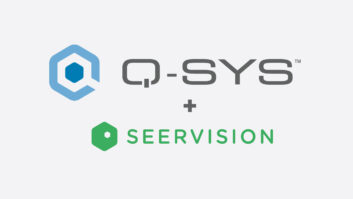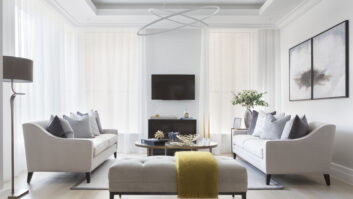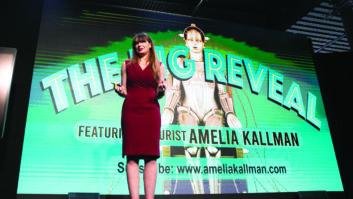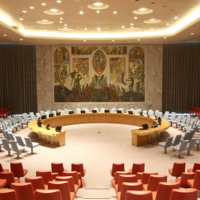
Far from being viewed in isolation, products bound for conference venues are now frequently perceived in terms of their contribution to a flexible, integrated AV/IT workspace. As David Davies discovers, this trend spells increasingly exhaustive feature-sets for many new systems.
As recently as a few years ago, it was possible to perceive conference systems as a series of fairly separate ‘blocks’, to be added and taken away in line with the requirements of each individual venue. If discussion, voting and interpretation capabilities were prerequisites for the vast majority of installations, then video display, video-on-demand and simultaneous language display could be among the stipulations of the more comprehensively realised conference spaces.
The passing years have intensified these expectations, but increasingly they are being catered to within the context of what Sennheiser UK’s Simon Druce summarises as “multi-faceted, all-encompassing conference venues”. Often incorporating sophisticated video and audio processing, such installations can be reconfigured quickly and easily to accommodate a variety of meeting scenarios.
It almost goes without saying, therefore, that manufacturers have had to prioritise ease of integration between their systems and those of other providers. This requirement is only destined to become more acute as companies operating multiple conference venues look to centralise their AV and IT infrastructures in order to minimise space consumption and further boost efficiency.
With the maintenance of corporate identity now extending to every facet of a company’s facilities, there is a simultaneous trend towards systems that are visually unobtrusive. It’s another sign of the times in a market sector whose perceived ‘reliability’ in terms of its contribution to revenue can occasionally mask an impressive rate of change.
Improving the user experience
Much more on the latest additions to system functionality anon, but first to answer a fundamental question: are venues themselves the agents of change, or are manufacturers adding new features on the basis of their own anticipation of arising market trends? The answer, unsurprisingly, would appear to be ‘a bit of both’, but with all developments primarily in the service of creating – in the words of Montse Romero, who handles international sales at Albiral Display Solutions – “environmentally sensitive, functional, adaptable, connected and interactive meeting spaces”.
@page_break@
For Youjie Shao, marketing manager at China-based conference systems developer Gonsin, “the changes in the functionality of Gonsin products are based on several major factors – mainly responding to specific needs for venues and anticipating new market trends.” The emerging trends, continues Shao, will be informed above all by the need to provide “more convenient, stable and intelligent equipment, how to improve the user experience, and how to be more energy-saving and more environmentally friendly”.
Responding to customer requirements may involve the development not only of ‘standard’ new product ranges, but bespoke solutions as well. Indeed, dealing with an individual customer’s needs can often trigger important new R&D. Manufacturers are also working with the awareness that, in many cases, the way in which conference systems are overseen and maintained has undergone a fundamental change.
“The responsibility for the day-to-day running of the systems has shifted,” confirms Druce, who is channel sales manager – distribution at Sennheiser UK. “Nowadays the install, running and maintenance of conference systems falls under the umbrella of the IT departments. Where this is happening, the equipment needs to be easily understood by IT engineers, and the protocols used have to be in line with IT expectations.”
Visual form…
With companies needing to involve more participants in conference scenarios both internally and externally, it is to be expected that the main developments in recent years for those providing equipment with visual capability have been greater interactive functionality and enhanced overall display quality.
“The changes that we have experienced over the recent past [have led us to develop] products for connected and more collaborative meetings. [Hence] we have added interactivity in our screens in order to enhance participation,” says Romero.
Taiden, too, has been working on the interactive functionality of its systems. In addition to enduring conference product requirements such as “discussion, voting and interpretation”, Taiden marketing director Nicolas Mreches identifies frequent requests for electronic document exchanges and video-on-demand. After several years of research, the company has responded to these expectations with the HCS-8300 paperless multimedia congress system. Equipped with a 7in/10in high-resolution LCD touchpanel, integrated three million pixel camera and nx8 audio matrix processor, the HCS-8300 is able to accomplish interactive conference control functions (speech, voting, SIS), paperless document management, video conversation and various video services. Fully digital, the system allows all audio and video signals to be transmitted via a Cat6 Gigabit network cable using Taiden’s own GMC-STREAM Gigabit multimedia congress stream technology.
@page_break@
Shure, too, has been thinking about the visual dimension of its systems, commencing a while back with the DIS DC 6990P conference unit that enables one-touch navigation and the display of multiple languages on the same console. “The introduction of the multiple delegate feature meant that units could be programmed to function as a chairman, delegate or dual delegate, and could then be personalised or shared by two people,” says Christopher Hellmuth, senior marketing manager installed product at Shure EMEA and formerly technical sales for DIS, which was acquired by Shure in early 2011.
In tandem with this increased emphasis on visual capability is a need for systems to be aesthetically discreet – no surprise when, increasingly, the concept of maintaining corporate image extends to every area of a company’s facilities, including the boardroom.
There is, then, says, Romero, a call for solutions that can be “delivered with custom finishes according to the interior design and corporate identity of each entity”. And that’s not all: “We have also noticed [a demand for the] flexibility of the workspace and sustainability, [and] that is why we design and manufacture retractable, foldable and rotatable screens that can disappear within the meeting table desk without leaving a trace.”
Hence, from Albiral’s Arthur Holm brand, products such as the Dynamic 3 multipurpose motorised monitor system. “The screen opens and closes with a motorised movement similar to a laptop, with the peculiarity that it can turn 180º once in the ‘up’ position, facilitating the sharing of information with the person located in front of the user. It can be folded into the desk, but with the screen facing up or facing down,” explains Romero.
…Audio function
For manufacturers whose primary specialism is audio, many recent developments are linked by the common thread of boosting flexibility and minimising installation-related labour. Hence, in particular, the increasing ubiquity of solutions with wireless capability.
Not only does Sennheiser’s LSP 500 PRO wireless loudspeaker “eliminate the need for time-consuming laying of cables”, says Druce, “it also comes with an app that enables up to 20 loudspeakers to be remotely controlled at the same time.” The app “essentially takes over the functions of a mixing console”, so whether it be the volume, the equaliser or the delay it is possible to “configure everything from individual speakers to groups of speakers, as well as the audio sources connected to them”.
Shure is also continuing to capitalise on the flexibility of wireless audio with the recent introduction of its Microflex Wireless System (MXW), a microphone solution geared towards enterprise-scale AV environments. Hellmuth remarks: “Every system shares the same building blocks: four wireless microphone options, two intelligent networking components and a remote networked charging station. Easy to configure and expand, Microflex Wireless solutions easily scale from custom boardrooms to networked enterprises.”
In conjunction with flexibility and scalability, the other main impulse appears to be ease of control and adjustment. Taiden, for example, points to its new HCD-8301M digital audio mixer for conference systems, which is a 15-channel hardware mixer with up to six active microphones and incorporating 11 banks of simultaneous interpretation audio. “The mixer’s 10in LCD touchscreen enables users to monitor audio levels, language channels and system connection. It also gives access to the mixer’s internal settings, for example IP and network settings, while every setting and adjustment on the mixer is in sync with the PC software real-time,” says Mreches.
Networking capability
Manufacturers have also been responding to requests to expand their systems’ networking functionality. Invited to consider the next paradigm shift for AV in conference venues, AKG’s Thomas Giczy doesn’t hesitate: “Networking!
IP-based microphone stations and cameras accessible from any point of a house network.”
As in other install sectors, making different systems work together will require manufacturers and end-users to alight on a highly select number of widely accepted networking technologies. At present, Audinate’s Dante media networking technology appears to be setting the pace, with Televic confirming that its new multimedia conferencing system, uniCOS, will incorporate a Dante interface as this article was being completed.
“We see a growing need with our customers to interface their conference system digitally with third-party equipment,” says Bart Deschodt, general manager of Televic Conference. “We are excited to integrate Dante in our new products, not only because of its performance, but also because Dante has become the standard in digital audio networking.”
Bosch Security Systems is also working with Dante, and at this year’s Prolight + Sound exhibited DCN multimedia. The new solution is the first IP-based conference system built on the OMNEO platform, which combines Dante audio networking with an open control architecture defined by the Open Control Alliance (OCA). “We strongly believe that next to standardised media transport, a standardised control architecture should become available to make networked audio or media a success,” says Lars van den Heuvel, senior product manager conference systems, Bosch Security Systems.
@page_break@
Dante, of course, is perceived in some quarters as a likely ‘pathway’ to the implementation of Audio/Video Bridging-based networking, and with the related audio standards now approaching completion, manufacturers are beginning to promote conference systems’ AVB capability.
beyerdynamic’s Quinta conferencing system is a case in point. Quinta, says Matt Taylor from UK beyerdynamic distributor Polar Audio, “takes push-to-talk conferencing to a new level. As well as being very frequency agile, it adopts AVB with multi-zone output capability for grouping microphones.”
The great convergence
Many of the manufacturers who spoke to Installation for this feature cited growing demand for systems to be expandable in line with changing requirements. Accordingly, an increasing number of systems are being promoted on the grounds of a ‘modularity’ that eases future expansion and system upgrade.
Gonsin’s DCS-1020 Daya distributed congress system is one such innovation. “Thanks to unconventional design and unique user experience, the DCS-1020 series offers an ideal choice of product for customers compared with traditional conference systems,” says Shao, pointing to a feature-set that also includes: a 4.3in TFT true colour touchscreen and interactive GUI; seamless integration of wired and wireless terminals; a web-based login interface for remote congress management and system online update; and Cloud technology for faster real-time data processing.
But although the feature-set of many conference solutions has grown considerably over the past few years, there is nonetheless the sense that we are currently on the verge of a much greater shift in which systems take their place in a fully collaborative context unburdened by barriers of technology or geography.
Looking ahead “from a macro point of view”, says Shao, “conference systems will be horizontally expanded from single AV technology to adjacent industries, and will be integrated into large smart platforms such as the Internet of Things and the Smart City”.
As in other install markets, this shift will necessitate continued convergence between different system types. “While we did see audio, video and IT as separate platforms, there is now a need for them to converge,” says Hellmuth. “Therefore, ‘interoperability’ and ‘networkability’ will be key; different types of products from different domains, both technically and geographically, will need to function together.”
With the video side of the project now gaining ground, the aforementioned AVB, it is generally believed, is likely to be integral to this convergence. “The technology has slowly been moving this way for a long time,” says Taylor, “but it has not been until the advent of AVB in audio products that a technology [has emerged] to guarantee audio and video across a computer network without it affecting data on that network and without that data affecting the audio and video transmission.”
The reality is that the final outcome of the convergence trend is unclear, and it will likely be several years before we have a real sense of the lay of the land. What’s for certain, however, is that new systems will need to be sufficiently versatile and open to expansion in order to earn their place in the next generation of conference spaces. n
www.akg.com
www.albiral.com
www.beyerdynamic.com
www.boschsecurity.com
www.digico.biz
www.gonsin.com
www.polaraudio.co.uk
www.sennheiser.com
www.shure.com
www.taiden.com
www.televic-conference.com
